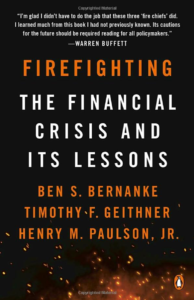Firefighting: A Plea for Discretion
 Firefighting, the new primer on the financial crisis by the all-star team of Ben Bernanke, Timothy Geithner and Henry Paulson (BGP), is a well written, short overview of the consensus position on the U.S. financial crisis. The book has a number of good lines:
Firefighting, the new primer on the financial crisis by the all-star team of Ben Bernanke, Timothy Geithner and Henry Paulson (BGP), is a well written, short overview of the consensus position on the U.S. financial crisis. The book has a number of good lines:
…financial institutions, unlike other businesses whose success depends primarily on the cost and quality of their goods and services, are dependent on confidence. That’s why the word “credit” comes from the Latin for “belief,” why we say we can “bank” on things we know to be true, why some financial institutions are called “trusts.”
…the most damaging problem with America’s capital rules was not that they were too weak, but that they were applied too narrowly.
Risk, like love, will find a way.
Firefighting offers a summary, consensus view of the causes of the crisis:
…the basic problems were too much risky leverage, too much runnable short-term financing, and the migration of too much risk to shadow banks where regulation was negligible and the Fed’s emergency safety net was too inaccessible. There were also too many major firms that were too big and interconnected to fail without threatening the stability of the system, and the explosion of opaque mortgage-backed derivatives had turned the health of the housing market into a potential vector for panic. Meanwhile, America’s regulatory bureaucracy was fragmented and outdated, with no one responsible for monitoring and addressing systemic risks.
Consult Adam Tooze’s magisterial Crashed for a more European and global view of the crisis, Hetzel’s The Great Recession for an explanation of the crisis based on monetary rather than financial disorder and Larry Ball’s The Fed and Lehman Brothers: Setting the Record Straight on a Financial Disaster for an exhaustive and different accounting of the politics especially around the decision not to bail out Lehman.
Given that the book takes a consensus view and given that all three authors have written previous books on the crisis, one might wonder why BGP wrote Firefighting. The answer is in two parts. Most importantly, Firefighting is a plea for discretion. At one point BGP write surprisingly directly if euphemistically:
The Fed also reinterpreted its emergency lending authority in creative ways to avert catastrophic collapses of Bear Stearns and AIG…
In other words, the Fed broke the law. That, at least, is how many in Congress saw it after the fact which is why Congress asserted its authority over banking by rewriting the rules but also removed a lot of discretionary authority from the Federal Reserve and the Treasury.
Overall, while the United States has much stronger safeguards against the occurrence of panic than it had before the crisis, it has weaker emergency authorities for responding when a panic occurs. Its crisis managers lack the power to inject capital, guarantee liabilities, or purchase assets without going to Congress…the Fed has lost its power to rescue individual firms and faces new constraints on its lending powers, while the Treasury has lost its ability to use the Exchange Stabilization Fund for guarantees.
What Congress takes it can also give but BGP are not sanguine about the effectiveness of American democracy:
…when an epic crisis does arrive, Congress would have the power to undo the preemptive limitations it has placed on crisis managers. But that is easier said than done in a nonparliamentary democracy where legislative changes require support from the president, the House of Representatives, and a filibuster proof majority in the Senate…it’s hard to look at the bitterly polarized politics of modern America and feel confident that a bipartisan consensus for unpopular but necessary actions would emerge when it mattered most.
Thus, BGP come down solidly on the side of technocracy and discretion rather than democracy and rules.
I believe the second reason that Bernanke, Geithner and Paulson wrote Firefighting is that they want their account of the crisis to be the history taught to the next generation. To that end, Firefighting is indeed a useful guide for teaching the crisis and is particularly good on timelines, major events and policy actions. About a third of Firefighting is a series of standalone charts (which aren’t even referenced within the text). Oddly, however, the book never tells you that the charts are available online, neither does the book’s homepage, but a little Google sleuthing uncovers that the charts were produced in cooperation with the Brookings Institution and can be found here. Anyone wanting to teach the crisis will find what they need in the charts supplemented of course with the discussion of financial intermediation in Modern Principles and the MRU videos on the Great Recession and the various Business Cycle Theories.